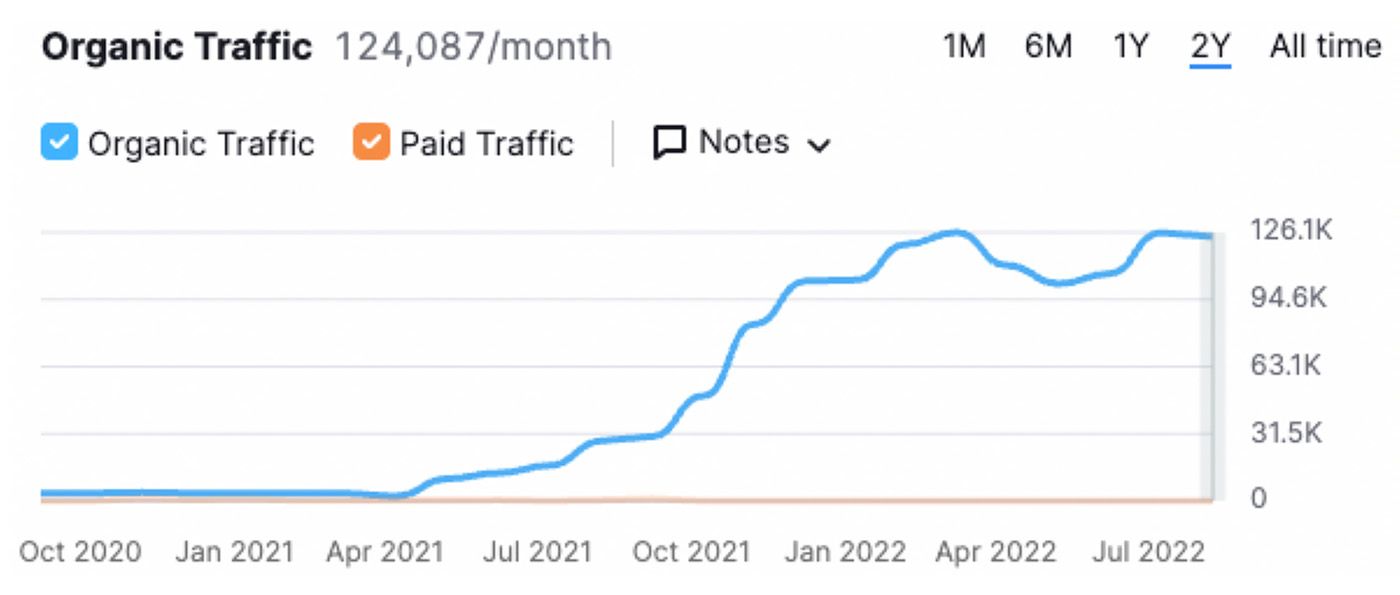The extremely unoriginal story of how Shorthand does SEO

The not-at-all unique story of how we increased Shorthand’s blog traffic by 10x in eight months — and what went wrong along the way.
by Matt McGregor
The biggest threat to success in content marketing is short-term thinking. As an industry, we’re plagued by influencers promising growth hacks and shortcuts.
These growth hacks are always tempting — after all, who doesn’t love an easy win? But here’s the annoying truth: Success in content marketing generally follows the patient application of widely accepted fundamentals.
To make my case, I’m going to dive into Shorthand's recent experience with SEO. Consider it a case study in diligent unoriginality.
And, let’s face it, it’s a prime opportunity for a humble brag.
Here’s what I’m going to cover:
- The humble brag
- How did Shortand grow its organic traffic 10x in eight months?
- The starting place
- The advice I followed
- The advice I took and regretted
- The advice I didn’t take and was glad
- What went wrong
- What happens next
The humble brag

Here’s the brag. From July 2021 to around February 2022, the organic traffic to Shorthand’s blog grew at a fantastic rate. The graph from SEMRush shows you what that looks like. The numbers aren’t accurate, but the trend is.
Pretty, isn’t it? But there, over the last six months, you can also see the ‘humble’. We didn’t continue growing at nearly the same rate after the beginning of the year. We even experienced some steep declines.
The reasons for our successes and failures won’t be a surprise to anyone with experience in SEO and content marketing. I’m not personally an SEO guru, and if you’re looking for a ‘definitive guide for SEO success’, you’ve come to the wrong place. But if you’re anything like me, you need to learn the basics many times over before it finally sinks in.
How did we grow organic traffic 10x in eight months?

For a while, people internally — and externally, too — were asking how I did it.
The first answer is: I didn’t. It was a hugely collaborative effort. Now that I’m in management, I’ll happily take credit for people’s work, but I should acknowledge that I didn’t personally do most of it. I had the internal support of my boss Karen Robinson and our story designer Scott Moorhead. And we had a great bunch of freelancers, including Kiera Abbamonte, Kimberlee Meier, Corinna Keefe, and Marissa Sapega.
Though I will say this. I was the only content person for most of the year, and we were always competing with much larger companies with much larger teams and budgets. I think anyone working in content should take heart in this. It’s seriously possible for small teams — or teams of one — to outmanoeuvre much, much larger operations.
The second answer is in the title of this post. We grew traffic in the most boring, unimaginative, downright tedious way possible: I researched what other people had done, and I copied them. I mean, not literally. Our content is extremely original, thank you very much. But tactically, I just followed best practice, to the best of my ability and budget, week in, week out.
No new tricks. No hacks, games, or workarounds. Nothing you couldn’t read about in a hundred other places.
It’s an extremely unsatisfying answer, and one I had to repeat to management a few times over before anyone believed me. People love a shortcut, a workaround, a Growth Hack™; but most successful content marketing, most of the time, is just the result of a sound, unoriginal strategy pursued with diligence, craft, and care.
The starting place

Shorthand’s content prior to this point was fairly typical of most smaller companies (and even some bigger ones). We had a blog, and the company published stuff to that blog on occasion. From an SEO perspective, there were some successful posts, but they weren’t all well-aligned with the needs of the business, and traffic had basically been flat for a year or so.
This isn’t to criticise anyone. Kicking off a repeatable content engine isn’t easy with a small, scrappy team. In my experience, great content operations require a specialist person to be plugging away, week after week, without distraction. That’s a luxury at small startups, where there are always too many other priorities.
When I came on board, I was that specialist person. I joined in April 2020, and for the first year I didn’t focus much on SEO. We had recently moved upmarket, and my major focus was expanding our marketing site and writing opinionated pieces (like the decline of the PDF, or the death of the press release) to power our targeted paid social campaigns.
After a year of plugging away at that, though, it became clear that organic search was a major gap in our content strategy. I had some experience in SEO, but I knew I needed to level up to get the results we wanted.
Recklessly, I promised our CEO that I’d grow our traffic by 10% MoM (something we’d never come close to achieving). And then — in a mild panic, sweat beading from my forehead — I scoured the web for smart people to steal ideas from.
The advice I followed

If you’re a team of one, don’t write
This advice was frankly mind-blowing when I first heard it (I think originally misreading the conclusion of this post from Sean Blanda). I come from a writerly background, and the only reason anyone would be mad enough to hire me into a software company was because I could string a sentence together.
Initially, this set off a mild existential crisis (I don’t write?), which was offset shortly afterwards by my profound laziness (I don’t write!). But it transformed our content strategy overnight. Now, instead of spending my best hours each week resculpting overwrought sentences, I could focus on research, editing, publication, and distribution.
I’m aware that some superhuman content marketers can do all of this themselves. I am not, alas, such a superhuman. I also don’t think you have to be, or should even try to be.
Hire freelancers and pay them properly
Obviously, this follows from my first point. If you’re not going to write, you’ve got to find some folks who will. There’s no particular source to this one, but I think basically all the content professionals I respect sing from this song sheet.
How did I hire great freelancers? Again, no special shortcuts here. I did some light Googling, put an ad out on a content marketing community, and tested out six or seven freelancers. And then I paid them properly.
That last point is the most important. With some exceptions, cheap writers will cause more trouble than they’re worth. The entire point of hiring freelancers is that they can write excellent top-of-funnel content that requires only minimal editing prior to publication. If they can’t write well, then they’ll either 1) ruin your brand reputation with their terrible content or 2) ruin your day by causing you to edit and rewrite their crap.
Ideally, you want to incentivise your freelancer to put the best hours of their day into writing for you. If they have to write ten pieces a week to make rent, that isn’t going to happen.
Avoid shiny objects
Ambitious content marketers love big projects. We’re always keen to sink our teeth into something more substantial than a 1500 word blog post. And in content, there’s always another format to try. But as I’ve learned from experience, if you chase every shiny object, you’ll spread yourself too thin, and end up failing across the board.
As the title to this post suggests, the longer I work in this field, the more boring I get. Maybe I’m just getting old (I am), but I like repeatable processes over big flashy rolls of the dice.
Report on your progress
This is both obvious and annoying advice. I mean, shouldn’t our managers just know what we’re doing and praise us for it? Turns out they don’t — and if you don’t actively report on your progress, they’re not going to understand how your work is progressing.
This is arguably more important for SEO content than just about anything else. SEO takes a few months to start working, and that freelance line will always get a close look from your finance team when budgets are tight. If you want to succeed, you need your managers to have your back when those conversations are happening. This is because they often happen fast, and you want them to know your narrative inside and out when they do.
If you want a good template for content reporting, check out the resources Jimmy Daly made for Superpath Pro. Skip that tacky marketing conference and do this instead. Money well spent, IMO.
Use specialist SEO software — but do it thoughtfully
I inherited a SEMRush subscription, which was excellent. But I soon learned that just about everyone I admired in content marketing was using a tool called Clearscope. This tool uses machine learning to suggest a range of terms — beyond your target search term — to help you show that your content is relevant to the intent of the search query.
But there’s a catch. SEO tools can incentivise the worst kind of keyword stuffing, so remember: you need to provide a useful, relevant response to the intent of a human searcher. You’ll want to show some real expertise or creativity in how you present that information to inform and delight a real human.
Follow a repeatable process
In content marketing, process is everything. The reason most blogs don’t work is because they lack a predictable process for generating content that works (whatever ‘works’ means — reputation, traffic, conversions, revenue).
This doesn’t mean you need to publish on a specific day every week. As Josh Spilker likes to note, Google doesn’t care when you publish. But you do need a process that allows this work to be predictable and repeatable.
This unoriginal post is long enough without listing Shorthand’s unoriginal process. As a rule of thumb, though, you want to know in detail the precise process you need to follow to be successful. Most importantly, you want to know how much work is involved at each step — and by whom — and factor that into your content planning and budgeting process.
Update old content
Every website has old blog posts that are lingering in the 20s to 50s in Google. This means that they’re not getting any organic traffic. But it can also mean that Google thinks you have the topical authority to potentially — if you play your cards right — land on the first page.
So throughout this period, I rewrote dozens of old articles. It didn’t always work, but when it did, the results were dramatic and immediate.
The advice I took and regretted

Write an ebook
Sometime in the early 2000s, marketing tech companies convinced everyone that the best way to generate leads was to write ebooks. The idea was that you could gate this ‘premium’ content, collect email addresses, and then ‘nurture’ people until they paid $20,000 for your software product.
I know this is a little glib. This tactic has indeed proven successful for many companies, but it's not in Shorthand's DNA to gate our content. Somehow, though, I still got it into my head that writing over 10,000 words on a single topic would still be a good idea.
Reader, it wasn’t. It sank like a stone.
I’ve personally never read an ebook that wasn’t a) on my Kindle and didn’t b) feature a murder in a quaint town, so lord knows why I thought this was a good idea. But, lesson learned.
The advice I didn’t take and was glad

Now, it’s true. I’m an impressionable young man. But not all the advice out there turned out to be great, and I’m glad I kept my bullshit detector — an absolutely essential device for anyone working in marketing — on high alert.
I didn’t publish as much as humanly possible
There are some companies that throw the kitchen sink at SEO, hiring dozens of writers from Upwork and publishing pieces every day. This is potentially good for traffic, but is an absolute travesty for the reputation of your brand.
I didn’t decide what to write based on search volume
It’s possible that we could radically grow Shorthand’s organic traffic by writing about high volume topics that are distant from our actual business or brand. Again, I decided we’d be sacrificing our brand to chase those keywords, so I stayed pretty close to our core expertise.
I didn’t chase backlinks
In SEO, everyone talks about backlinks, but I didn’t bother focusing on this — mostly because I couldn’t. It was too difficult a problem, too time-consuming, and too far outside my area of expertise. I think this was, accidentally, a pretty good idea. Shorthand was already pretty well established, so it wasn’t a major necessity for us.
Generally, though, I think begging for backlinks is a risky business for a SaaS company looking to build their brand.
I didn’t obsess about technical SEO
I understand that this is important. But here’s the golden rule that all writers learn the hard way. If a good idea requires a developer to implement, it’s no longer a good idea. It’s a fantasy. So I stayed away from technical SEO, except for absolute emergencies.
I didn’t pay attention to Domain Authority
If you use an SEO tool, it will create a measure of the ‘authority’ of your domain. It’s fine as a heuristic measure, but it won’t tell you anything you don’t already know. And it’s not an official Google metric, even though some folks act like it is. In my experience, topical authority — i.e. the evidence that your domain has specialist knowledge about a particular topic — is far more important.
What went wrong

I’ve saved the best to last. Here’s a list of everything that went wrong along the way. This section could be an entire post in itself. Most of the time, the problems were caused by Google being a total PITA. Once, the problem was caused by Amazon being a total PITA. But let’s start with the most important mistake.
I got busy
This is the big one. Late in 2021, some changes in leadership meant that I had to take on a few more marketing tasks. This included kicking off a podcast, launching some video projects, and attending quite a few more meetings. I then got promoted into management.
I managed to keep our content engine humming, but I was no longer putting in that extra — and totally critical — 20% of effort during the editorial process. Most critically, I also stopped updating old posts. In a competitive landscape, this is arguably more important than writing new posts, and definitely explains a good proportion of our organic traffic decline.
Google did Google
Ah, Google. It caused headaches in more ways than I can enumerate here, but let’s go over some basic annoyances.
No click searches
Over the course of the last decade, Google’s been slowly cannibalising traffic from other sites by answering search queries directly on the results page. This has led to the rise of ‘no click searches.’ We’ve suffered a few of those. Think high search volume, ranking #1, and… *crickets*.
Indexing problems
Sometimes, I would check pages in Google Search Console to find that they had just… disappeared. And new pages also became increasingly tricky to index in 2022.
All the things
Google has been gradually stuffing anything and everything into the top of the results page — YouTube videos, product carousels, news, images, 3-4 ads. In practice, this means that #1 ain’t what it used to be.
Seasonality
If you like a steady up-and-to-the-right chart, summer is a drag. So is Christmas. Come on, people. Your holidays are very inconvenient for my reporting. Let’s do better next year, huh?
AWS did AWS
AWS, in all its wisdom, decided at one point to block Google’s crawler from our site. That was a fun few weeks.
What happens next?

We like the protagonists of our stories to learn valuable lessons. But sometimes, the barrier to better results isn’t ‘knowing more stuff’ so much as ‘having more time to do the basics well’. While I’ve gone deeper in SEO over the last 12 months, the most important thing we did was hire two Senior Editors to own large chunks of our content strategy.
Recently, we’ve been moving onto our next phase of organic growth — but it’s not the central, or even most important, part of our content strategy. With editorial content, newsletter, and community, we’re also investing in what Sean Blanda calls the ‘moat’ of modern software companies. The moat is what makes it difficult for other companies to compete with your brand.
As he puts it:
In a hyper-competitive business where the gravity pulls the products down to commoditisation, the only advantages in this marketplace (the “moats”) are audience, community, and brand. Getting content right matters more than ever. Editorial is the life blood of this new way of operating. It provides the backbone of what every non-commodity brand is based on.
Here’s to Shorthand’s next unoriginal success story.


